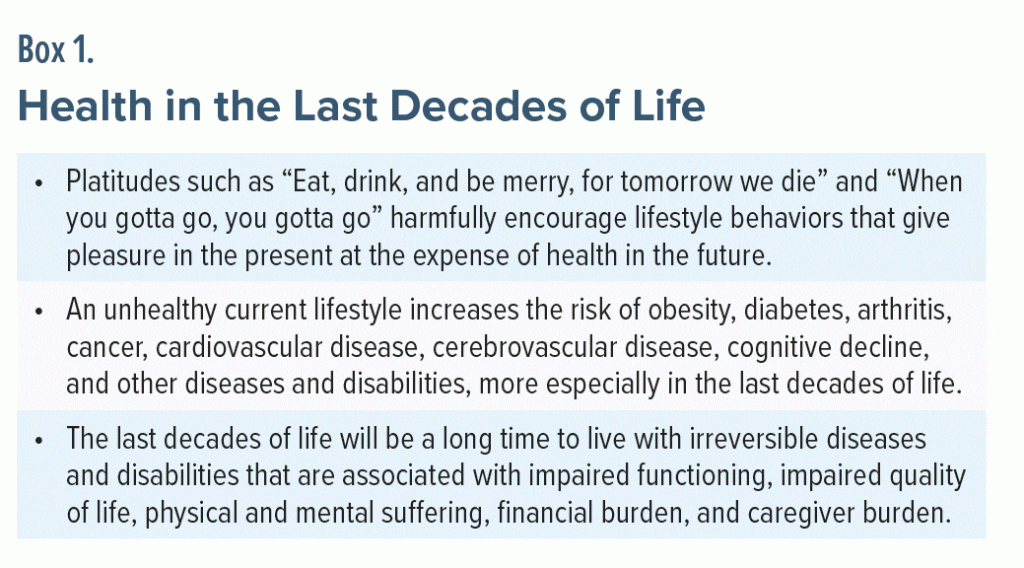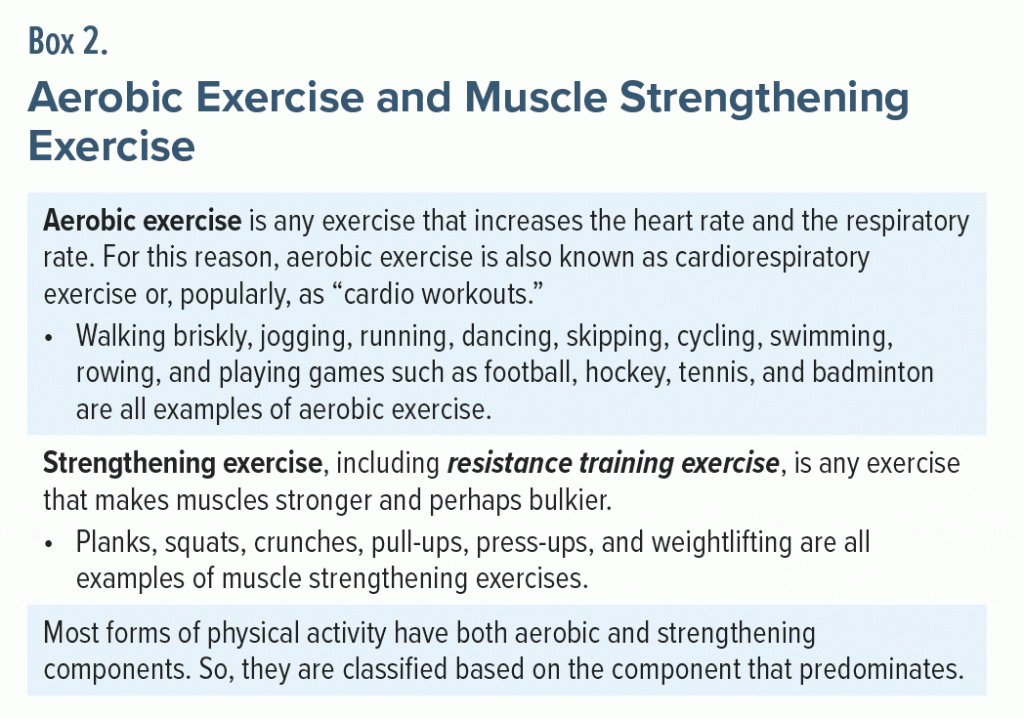ABSTRACT
Regular physical activity in any form is important for health; nevertheless, more than a quarter of adults and more than four-fifths of adolescents do not meet recommended thresholds for exercise. This article outlines the magnitude of the global problem. It discusses terms such as physical activity, aerobic exercise, muscle strengthening exercise, weight-bearing exercise, sitting time, and sedentariness. It presents and explains current guidance on physical activity, averaged across a week, for adults as well as special populations, including adolescents, the elderly, and pregnant women. It notes that immediate, short-term, and long-term benefits of exercise have been identified in thousands of randomized controlled trials (RCTs) and cohort studies, and pooled in hundreds of meta-analyses, for a wide range of neuropsychiatric and medical conditions. It explains the strengths and limitations of the RCT and cohort study data as well as explains how some of the limitations can and have been addressed. It demonstrates how the Bradford Hill criteria can be applied to support the credibility of the research findings. It outlines immediate as well as long-term risks associated with exercise, as well as factors associated with these risks. In summary, the benefits of exercise outweigh the harms, especially when exercise is performed in moderation and within the individual’s comfort zone. Although any physical activity is better than none, individuals should attempt to reach the currently recommended thresholds for exercise. There is little additional benefit associated with exceeding the guidance, and there may be immediate as well as long-term risks associated with overexercising. Finally, sitting time and sedentariness are constructs that are independent of physical activity; greater sitting time and greater sedentariness are both associated with poorer health outcomes and should therefore be discouraged at the same time that physical activity is encouraged.
J Clin Psychiatry 2023;84(5):23f15099
Author affiliations are listed at the end of this article.
Benjamin Franklin observed that nothing is certain except death and taxes. Given the certainty of death, almost everyone who is sound in mind and body would want to delay the inevitable for as long as possible. A corollary is that long life should be associated with good health. A further corollary, and one that is seldom planned for by those who are young, is that good health should extend into the last decades of life (Box 1).
Three necessities for a long and healthy life are related to lifestyle: healthy food habits, adequate sleep, and adequate exercise. All of these require to be maintained with regularity across the lifespan. This article explains why awareness about the subject is important to health care professionals, explains terminology, states current guidance, provides an overview of the benefits of exercise on aspects of physical and mental health, considers limitations of the research on the benefits of exercise, affirms that the research findings do provide a creditable message, discusses potential harms related to exercise, and reminds readers that sitting and sedentariness should be discouraged as much as physical activity and exercise should be encouraged.
Exercise: Relevance to Health Care Professionals
There are many reasons why health care professionals in general and mental health care professionals in particular need to be aware of the importance of regular exercise. First, a substantial proportion of the population is insufficiently active. As an example, a study of data from 1.9 million adults in 358 surveys conducted in 168 countries estimated that the age-standardized global prevalence was 27.5% for failure to meet a minimum target of 75 min of vigorous physical activity or 150 min of moderate physical activity per week, or any equivalent combination thereof; this prevalence was 23.4% vs 31.7% in men vs women.1 Another study of data from 1.6 million students (aged 11–17 years) in 298 surveys conducted in 146 countries found that the global prevalence of insufficient physical activity was an astonishing 81%; the prevalence was 77.6% vs 84.7% for boys vs girls.2 In a nationwide observational prospective cohort study based on data obtained from the US National Health Interview Survey for the period 1997–2018, 35% of 500,705 adults did no moderate or vigorous leisure time aerobic exercise, and did muscle strengthening exercise at less than the recommended frequency of twice a week.3 These statistics are of concern because lower levels of exercise are associated with poorer health outcomes, as is explained later in this article.
Second, low levels of exercise and sedentary behavior are common in persons with major mental illnesses such as schizophrenia, bipolar disorder, and major depressive disorder. Inadequate exercise and sedentary behavior in these disorders are associated with higher cardiometabolic risks, poorer global functioning, poorer quality of life, greater severity of depressive symptoms, longer duration of illness, and higher levels of antipsychotic dosing. Inadequate exercise and sedentariness may explain why persons with major mental illness die up to 15 years earlier due to medical comorbidities.4,5
Third, preventive medicine is arguably the most important branch of medicine, and if levels of exercising were to increase in the population, health and life expectancy in the population would improve and costs related to health care would decrease. It is therefore important for health care professionals to be aware of the importance of providing guidance regarding exercise to all patients whom they see.
Exercise: Terminology
It is necessary to understand terminology when reading research and guidance on exercise.
In common parlance, physical activity is any waking hour activity, regardless of nature and purpose; in contrast, exercise is leisure time activity, performed for pleasure, strength and appearance, and/or health. In research contexts, these two terms should be understood as defined in the research article; the definitions can vary across studies. In the context of health guidance, physical activity and exercise are conceptually interchangeable terms. In this article, as well, the terms physical activity and exercise are used interchangeably. Readers may note that sitting time and sedentariness, which are not synonymous terms, are also relevant lifestyle behaviors because both have a negative impact on health. Sitting time and sedentariness are independent constructs; they are not merely the absence of recommended levels of physical activity. Sitting time and sedentariness are briefly discussed at the end of this article.
Two main categories of exercise are recommended for health: aerobic exercise and muscle strengthening exercise (Box 2). In addition to increasing heart and respiratory rates, aerobic exercises strengthen different groups of muscles to different degrees. In addition to strengthening muscle, strengthening exercises increase heart rate and respiratory rate to different degrees. That is, no exercise is exclusively aerobic or exclusively strengthening. So, exercises are classified as aerobic or strengthening based on what they predominantly do. As an example, running up several flights of stairs has a clearly apparent aerobic element whereas slowly climbing up the stairs is more strengthening than aerobic.
Other terms are used. Weight-bearing exercise loads and hence helps strengthen bone. Weightlifting, climbing stairs, and even walking are weight-bearing exercises. In contrast, swimming and cycling have low weight-bearing value.
Exercise may also be classified as isotonic vs isometric; this classification is rarely referred to in health guidance. Finally, exercising also includes stretching and balancing exercises, both of which have few aerobic or strengthening elements. The nature and importance of these will be discussed in a later article on practical aspects of exercise.
Exercise: Guidance
The World Health Organization (WHO) guidelines on physical activity and sedentary behavior recommend at least 150–300 min of moderate aerobic exercise per week or at least 75–150 min of vigorous aerobic exercise per week, or equivalent combinations thereof, along with muscle-strengthening exercise at a frequency of at least twice a week. Muscle strengthening activity must exercise all the major muscle groups of the body and should be performed at least at moderate intensity.6
With regard to this guidance, if an individual rates personal exertional capacity on a 0–10 scale, a rating of 5–6 qualifies as moderate aerobic physical activity, and 7–8 as vigorous aerobic physical activity. Importantly, the minutes that count toward activity can accrue from any form of physical activity, including activity related to household work, occupation, and movement between places; that is, the recommended minutes need not arise during leisure time exercise, alone. Furthermore, such minutes can be cumulated across the day and week and do not need to be completed each day in one or more designated sessions of activity set apart to meet the target.6
Other operationalizations of exercise intensity have also been suggested. For example, moderate physical activity is activity that is associated with a moderate increase in sweating, breathing, and heart rate, and vigorous activity is activity that is associated with a substantial increase in sweating, breathing, and heart rate.3 Another simple operationalization is that moderately intense exercise (eg, brisk walking) is when the person exercising can speak but not sing, and high intensity activity (eg, running) is when the person can neither sing nor converse.7
The guidance6 stated above applies specifically to adults. Separate guidance is available for specific demographic groups. For example, children and adolescents should average at least 60 min of moderate to vigorous intensity aerobic activity per day as well as some activity that strengthens muscles and bone. Elderly persons should exercise as do adults but must perform muscle strengthening activity at least thrice a week, as well as exercise that improves their balance. During pregnancy, women should exercise at moderate intensity for at least 150 min per week; had they been exercising at higher intensity before pregnancy, they can continue with vigorous exercise during pregnancy and afterward. People living with chronic conditions and those with disabilities require individualized guidance.6
Exercise: Benefits
Thousands of randomized controlled trials (RCTs) and non-randomized observational studies, pooled in hundreds of meta-analyses, have described the immediate, short-term, and long-term benefits of different kinds of exercise in persons in the general population as well as in persons with specific disorders. Most of the studies cited in support in the following paragraphs are meta-analyses.
Exercise may have an immediate though transient anxiolytic8 and even euphoric9 effect. Exercise has been shown to improve subjective well-being10 and health-related quality of life11; reduce anxiety,12 depression,13 and suicide attempts14; improve sleep15; improve cognitive test performances16; improve sexual functioning17; improve pregnancy outcomes18; reduce the severity of chronic pain19; improve bone mineral density20 and reduce the risk of falls21 and fractures22; reduce cardiometabolic risk factors such as overweight and obesity,23 dyslipidemia,24 and hypertension25; improve metabolic outcomes in prediabetes26 and diabetes27; reduce the risk of infection and mortality therefrom28,29; reduce the risk of different cancers30,31; reduce the risk of neurodegenerative disorders such as Parkinson32 and Alzheimer disease33; reduce cardiovascular34 and cerebrovascular35 disease events in both primary and secondary prevention36; reduce the risk of heart failure37; and reduce cancer, cardiovascular, and all-cause mortality.3 This list is not comprehensive.
Exercise is also recognized to be potentially beneficial or at least permissible in persons for whom it was previously restricted or proscribed. This includes persons with knee or hip osteoarthritis,38 intervertebral disk prolapse,39 congestive heart failure,40 myocardial infarction,34 and other conditions. Finally, as has been known for long, exercise is the backbone for rehabilitation across a wide range of medical and neuropsychiatric disorders.
Interestingly, some data suggest benefits of exercise, especially aerobic exercise, for negative and other symptoms of schizophrenia.41,42 In persons with schizophrenia, benefits with aerobic exercise have also been observed on measures of social, occupational, daily, and global functioning.43
Interpreting the Research: Caveats
Almost all the evidence for the health benefits of exercise comes from RCTs and cohort studies. RCTs on exercise have mostly examined immediate or short-term changes, such as changes in mood, cardiovascular, respiratory, metabolic, and other parameters. RCT durations have ranged from minutes to hours after a session of exercise, on the one hand, to weeks to a few months after the initiation of an exercise program, on the other. Such RCTs provide cause-effect evidence for the mechanisms underlying the benefits of exercise as well as cause-effect evidence for short-term benefits of exercise programs in patients with neuropsychiatric or medical disorders. The cohort studies have been both prospective and retrospective, and follow-up durations have commonly been in the 5- to 10-year range.
A limitation of the RCT data is that it is not possible to blind subjects to their assigned intervention when the intervention is of a nature that is as obviously evident as aerobic exercise or resistance training. So, expectations about exercise can bias assessment of outcomes after exercise (vs control intervention) in conditions such as anxiety, depression, and chronic pain. A greater problem is that patients who are unwilling to exercise and those who do not expect to benefit from the intervention are unlikely to consent to participate in RCTs that study exercise44; so, the sample may self-select for an expectancy bias.
These problems are absent in cohort studies because cohort studies on exercise were not constituted specifically to study exercise and because outcomes in cohort studies were studied for everybody in the cohort and not just in those who were favorably inclined toward exercise. Another positive about the cohort studies is that the long follow-up allows the study of long-term outcomes. Finally, the outcomes assessed in cohort studies are usually objectively verifiable; such outcomes include the incidence of disease events or of mortality related to disease events.
The biggest limitation of cohort studies is that subjects are not randomized to their respective behaviors. So, outcomes related to levels of exercise may be unrelated to exercise-driven mechanisms; rather, they may be a result of the reason why the subject was exercising at that level. As an example, a subject who is poorly motivated may not exercise much. If poor motivation is a forerunner of apathy in Alzheimer disease, then this subclinical manifestation of Alzheimer disease, and not the lack of exercise, may explain the association of physical inactivity with the development of Alzheimer disease during follow-up. This is an example of reverse causation. That is, subclinical symptoms of Alzheimer disease were the cause of physical inactivity instead of physical inactivity being the cause of Alzheimer disease. So, poor motivation, in this example, is a confounding variable in a cohort study of whether lower levels of exercise are associated with an increased risk of Alzheimer disease.
In cohort studies, confounding is usually reduced by constituting the cohort to include only those subjects who are healthy at baseline, or subjects who do not have risk factors for the outcome of interest. However, subjects in whom the risk factor is subclinical cannot be identified and excluded.
Confounding in cohort studies is otherwise addressed by recording or measuring risk factors at baseline and then adjusting for them in statistical analyses. As examples, male sex, older age, and higher body mass index can be adjusted for when assessing cardiovascular outcomes at follow-up. The problem is that not all known confounds are measured. For example, amyloid and tau burden are risk factors that are not measured at baseline in cohort studies that examine whether exercising delays Alzheimer disease onset. Other confounds are poorly measured. For example, in Alzheimer disease studies, educational attainment or performance on a vocabulary test are merely proxies for cognitive reserve. Finally, still other confounds are unknown. These, for example, are genetic risk factors for the outcome of interest. Unmeasured, inadequately measured, and unknown confounds cannot be adjusted for in statistical analyses.
Confounding in cohort studies is also addressed by excluding from analysis subjects who develop the outcome implausibly early. In an example discussed earlier, investigators may choose to exclude patients who were diagnosed with Alzheimer disease within 3 years of study onset. This is because a current low level of exercise is unlikely to cause Alzheimer disease in such a short period; it is more likely that the low level of exercise was a marker for the disease in those who developed the disease implausibly early.
A difficulty presents itself here. What if a current low level of exercise is a marker for lifetime low levels of exercise? In such a case, it would be perfectly valid to include subjects who develop Alzheimer disease within 3 years of constitution of the cohort. The difficulty can be resolved by assessing exercise levels not just in the present but also at various times in the past, to the extent that such an assessment can reliably and validly be made.
A final limitation of cohort studies is that exercise levels are assessed only at baseline. No information is obtained on whether subjects persist at the same level of exercise, move to higher levels of exercise, or stop exercising. This is like studying long-term outcomes of schizophrenia without knowing anything about medication status after the baseline assessment. Ideally, exercise levels should be assessed periodically, and the information so obtained should be included in the regressions. That is, exercise should be examined as a time-varying variable. Unfortunately, this is almost never done.
As a result of these limitations, cohort studies can only conclude that there is an association between exercise and an outcome; cause-effect relationships between exercise and outcomes cannot be stated.
Interpreting the Research: Applying the Bradford Hill Criteria
If the research on exercise and health suffers from limitations, how does it justify the strong support that it enjoys? This is a situation in which the Bradford Hill criteria45 can be applied. These criteria were outlined more than half a century ago to help understand possible cause-effect relationships between environment and disease, such as between dust exposure and respiratory illness.
Research findings related to physical activity and exercise meet the Bradford Hill criteria to the extent that these criteria are contextually applicable. There is a strong association between lack of physical exercise and poor health outcomes. Studies conducted by different investigators in different places in different demographic groups have consistently found that physical activity is associated with a lower risk of adverse health outcomes. For many health outcomes, there is a temporal relationship: as physical activity increases, health outcomes improve. There is a gradient: higher levels of physical activity, to a point, are associated with greater health benefits. There is biological plausibility: many mechanisms have been identified that help explain why physical activity improves different health outcomes. There is coherence between evidence obtained from epidemiologic, RCT, laboratory, and other data on exercise and health. There is RCT evidence of at least immediate and short-term benefit.
In short, there is little doubt that, in general, exercise improves a wide range of health outcomes. However, as in all branches of research, every study should be weighed on its own merits. As examples, the possibility of placebo effects should be examined in RCTs of exercise in depression, the possibility of selection bias should be examined in RCTs of exercise in schizophrenia, and the possibility of reverse causation should be examined in cohort studies of physical inactivity and dementia. The last-mentioned possibility, in fact, appears plausible, based on findings from individual patient data meta-analysis: physical inactivity was associated with dementia only during the 10 years before diagnosis and not > 10 years before diagnosis.46,47
Exercise: Adverse Effects
Exercise,48 and even traditional forms of exercise, such as yoga,49 is associated with adverse effects. For example, especially if vigorous, exercise may be associated with fatigue and body ache that can persist into the next day; in some, delayed-onset muscle soreness (the DOMS syndrome) may uncommonly occur.50 If performed without sufficient warming up, or if incorrectly performed, or if performed using unsuitable shoes and gear, or if performed using unsuitable or defective equipment, or if warning physiological signals are ignored, or if the exerciser pushes beyond accustomed limits, exercise can result in musculoskeletal and other injuries, not all of which are reversible.
Dismayingly for those who are exercise enthusiasts, lifelong vigorous endurance exercise may cause cardiac adverse effects such as atrial fibrillation, atherosclerosis of the coronary arteries, dilatation of the aorta, and scarring of the myocardium. Vigorous exercise may even trigger ventricular fibrillation or myocardial infarction and sudden death.51,52 The upper level for exercise safety, especially for those who are in their forties or older, may be 4–5 h per week of vigorous exercise.53 Other than for sporting purposes, exercising at > 90% capacity is probably inadvisable. Sports injuries are out of the scope of this article.
Take-Home Message
The benefits of physical exercise clearly outweigh the harms. This is especially true when exercise is performed in moderation and with awareness of what activity, and level thereof, is safe and what activity, and level thereof, can result in injury. Individuals should exercise within their comfort zone, increasing levels of exercise as their fitness increases, yet remaining within their comfort zone. Although any physical activity is better than none, individuals should attempt to reach the thresholds recommended in the WHO guidelines.6 There may be little additional benefit associated with pushing levels of exercise beyond the recommended levels, and there may be orthopedic, cardiovascular, and other risks associated with overexercising; such adverse outcomes can occur during the exercise session as well as in the long run.
Parting Notes
This article has examined health benefits associated with physical activity and exercise. In this context, it must be noted that sitting time and sedentariness are associated with poorer health outcomes regardless of levels of physical activity.54–56 Readers may note that sitting and sedentariness, as lifestyle behaviors, are not necessarily associated with failure to meet required thresholds for physical activity. This is because, for example, persons with desk jobs and those with excessive exposure to television and other screen time may meet criteria for sedentariness but can simultaneously meet criteria for adequacy of physical activity; after all, all that it takes for the latter is to walk briskly for 30 min a day. Health care professionals should therefore encourage physical activity as well as discourage sedentary behaviors.
Article Information
Published Online: October 4, 2023. https://doi.org/10.4088/JCP.23f15099
© 2023 Physicians Postgraduate Press, Inc.
To Cite: Andrade C. Physical exercise and health, 1: an overview of terminology, guidance, benefits, and risks. J Clin Psychiatry. 2023;84(5):23f15099.
Author Affiliations: Department of Clinical Psychopharmacology and Neurotoxicology, National Institute of Mental Health and Neurosciences, Bangalore, India ([email protected]).
 Each month in his online column, Dr Andrade considers theoretical and practical ideas in clinical psychopharmacology with a view to update the knowledge and skills of medical practitioners who treat patients with psychiatric conditions.
Each month in his online column, Dr Andrade considers theoretical and practical ideas in clinical psychopharmacology with a view to update the knowledge and skills of medical practitioners who treat patients with psychiatric conditions.Department of Clinical Psychopharmacology and Neurotoxicology, National Institute of Mental Health and Neurosciences, Bangalore, India ([email protected]).
Financial disclosure and more about Dr Andrade.
References (56)

- Guthold R, Stevens GA, Riley LM, et al. Worldwide trends in insufficient physical activity from 2001 to 2016: a pooled analysis of 358 population-based surveys with 1·9 million participants. Lancet Glob Health. 2018;6(10):e1077–e1086. PubMed CrossRef
- Guthold R, Stevens GA, Riley LM, et al. Global trends in insufficient physical activity among adolescents: a pooled analysis of 298 population-based surveys with 1·6 million participants. Lancet Child Adolesc Health. 2020;4(1):23–35. PubMed CrossRef
- López-Bueno R, Ahmadi M, Stamatakis E, et al. Prospective associations of different combinations of aerobic and muscle-strengthening activity with all-cause, cardiovascular, and cancer mortality. JAMA Intern Med. 2023;183(9):982–990. PubMed CrossRef
- Vancampfort D, Firth J, Schuch FB, et al. Sedentary behavior and physical activity levels in people with schizophrenia, bipolar disorder and major depressive disorder: a global systematic review and meta-analysis. World Psychiatry. 2017;16(3):308–315. PubMed CrossRef
- Bort-Roig J, Briones-Buixassa L, Felez-Nobrega M, et al. Sedentary behaviour associations with health outcomes in people with severe mental illness: a systematic review. Eur J Public Health. 2020;30(1):150–157. PubMed
- Bull FC, Al-Ansari SS, Biddle S, et al. World Health Organization 2020 guidelines on physical activity and sedentary behaviour. Br J Sports Med. 2020;54(24):1451–1462. PubMed CrossRef
- Mottola MF, Davenport MH, Ruchat SM, et al. No. 367-2019 Canadian Guideline for Physical Activity throughout Pregnancy. J Obstet Gynaecol Can. 2018;40(11):1528–1537. PubMed CrossRef
- Sullivan AB, Covington E, Scheman J. Immediate benefits of a brief 10-minute exercise protocol in a chronic pain population: a pilot study. Pain Med. 2010;11(4):524–529. PubMed CrossRef
- Siebers M, Biedermann SV, Bindila L, et al. Exercise-induced euphoria and anxiolysis do not depend on endogenous opioids in humans. Psychoneuroendocrinology. 2021;126:105173. PubMed CrossRef
- Buecker S, Simacek T, Ingwersen B, et al. Physical activity and subjective well-being in healthy individuals: a meta-analytic review. Health Psychol Rev. 2021;15(4):574–592. PubMed CrossRef
- Ali A, Tabassum D, Baig SS, et al. Effect of exercise interventions on health-related quality of life after stroke and transient ischemic attack: a systematic review and meta-analysis. Stroke. 2021;52(7):2445–2455. PubMed CrossRef
- McDowell CP, Dishman RK, Gordon BR, et al. Physical activity and anxiety: a systematic review and meta-analysis of prospective cohort studies. Am J Prev Med. 2019;57(4):545–556. PubMed CrossRef
- Heissel A, Heinen D, Brokmeier LL, et al. Exercise as medicine for depressive symptoms? a systematic review and meta-analysis with meta-regression. Br J Sports Med. 2023;57(16):1049–1057. PubMed CrossRef
- Fabiano N, Gupta A, Fiedorowicz JG, et al. The effect of exercise on suicidal ideation and behaviors: a systematic review and meta-analysis of randomized controlled trials. J Affect Disord. 2023;330:355–366. PubMed CrossRef
- Kelley GA, Kelley KS. Exercise and sleep: a systematic review of previous meta-analyses. J Evid Based Med. 2017;10(1):26–36. PubMed CrossRef
- Sanders LMJ, Hortobágyi T, la Bastide-van Gemert S, et al. Dose-response relationship between exercise and cognitive function in older adults with and without cognitive impairment: a systematic review and meta-analysis. PLoS One. 2019;14(1):e0210036. PubMed CrossRef
- Silva AB, Sousa N, Azevedo LF, et al. Physical activity and exercise for erectile dysfunction: systematic review and meta-analysis. Br J Sports Med. 2017;51(19):1419–1424. PubMed CrossRef
- Gascoigne EL, Webster CM, Honart AW, et al. Physical activity and pregnancy outcomes: an expert review. Am J Obstet Gynecol MFM. 2023;5(1):100758. PubMed CrossRef
- Hayden JA, Ellis J, Ogilvie R, et al. Some types of exercise are more effective than others in people with chronic low back pain: a network meta-analysis. J Physiother. 2021;67(4):252–262. PubMed CrossRef
- Mohebbi R, Shojaa M, Kohl M, et al. Exercise training and bone mineral density in postmenopausal women: an updated systematic review and meta-analysis of intervention studies with emphasis on potential moderators. Osteoporos Int. 2023;34(7):1145–1178. PubMed CrossRef
- Sherrington C, Michaleff ZA, Fairhall N, et al. Exercise to prevent falls in older adults: an updated systematic review and meta-analysis. Br J Sports Med. 2017;51(24):1750–1758. PubMed CrossRef
- Hoffmann I, Kohl M, von Stengel S, et al. Exercise and the prevention of major osteoporotic fractures in adults: a systematic review and meta-analysis with special emphasis on intensity progression and study duration. Osteoporos Int. 2023;34(1):15–28. PubMed CrossRef
- Recchia F, Leung CK, Yu AP, et al. Dose-response effects of exercise and caloric restriction on visceral adiposity in overweight and obese adults: a systematic review and meta-analysis of randomised controlled trials. Br J Sports Med. 2023;57(16):1035–1041. PubMed CrossRef
- Martínez-Vizcaíno V, Amaro-Gahete FJ, Fernández-Rodríguez R, et al. Effectiveness of fixed-dose combination therapy (polypill) versus exercise to improve the blood-lipid profile: a network meta-analysis. Sports Med. 2022;52(5):1161–1173. PubMed CrossRef
- Edwards JJ, Deenmamode AHP, Griffiths M, et al. Exercise training and resting blood pressure: a large-scale pairwise and network meta-analysis of randomised controlled trials. Br J Sports Med. 2023;bjsports-2022-106503. PubMed CrossRef
- Edwards JJ, Deenmamode AHP, Griffiths M, et al. Exercise training and resting blood pressure: a large-scale pairwise and network meta-analysis of randomised controlled trials. Br J Sports Med. 2023;bjsports-2022-106503. PubMed CrossRef
- Peng Y, Ou Y, Wang K, et al. The effect of low volume high-intensity interval training on metabolic and cardiorespiratory outcomes in patients with type 2 diabetes mellitus: a systematic review and meta-analysis. Front Endocrinol (Lausanne). 2023;13:1098325. PubMed CrossRef
- Chastin SFM, Abaraogu U, Bourgois JG, et al. Effects of regular physical activity on the immune system, vaccination and risk of community-acquired infectious disease in the general population: systematic review and meta-analysis. Sports Med. 2021;51(8):1673–1686. PubMed CrossRef
- Sittichai N, Parasin N, Saokaew S, et al. Effects of physical activity on the severity of illness and mortality in COVID-19 patients: a systematic review and meta-analysis. Front Physiol. 2022;13:1030568. PubMed CrossRef
- Moore SC, Lee IM, Weiderpass E, et al. Association of leisure-time physical activity with risk of 26 types of cancer in 1.44 million adults. JAMA Intern Med. 2016;176(6):816–825. PubMed CrossRef
- Stamatakis E, Ahmadi MN, Friedenreich CM, et al. Vigorous intermittent lifestyle physical activity and cancer incidence among nonexercising adults: The UK Biobank Accelerometry Study. JAMA Oncol. 2023:e231830. PubMed CrossRef
- Portugal B, Artaud F, Degaey I, et al. Association of physical activity and parkinson disease in women: long-term follow-up of the E3N cohort study. Neurology. 2023;101(4):e386–e398. PubMed CrossRef
- López-Ortiz S, Lista S, Valenzuela PL, et al. Effects of physical activity and exercise interventions on Alzheimer’s disease: an umbrella review of existing meta-analyses. J Neurol. 2023;270(2):711–725. PubMed CrossRef
- Dibben GO, Faulkner J, Oldridge N, et al. Exercise-based cardiac rehabilitation for coronary heart disease: a meta-analysis. Eur Heart J. 2023;44(6):452–469. PubMed CrossRef
- Lee CD, Folsom AR, Blair SN. Physical activity and stroke risk: a meta-analysis. Stroke. 2003;34(10):2475–2481. PubMed CrossRef
- Winzer EB, Woitek F, Linke A. Physical activity in the prevention and treatment of coronary artery disease. J Am Heart Assoc. 2018;7(4):e007725. PubMed CrossRef
- Aune D, Schlesinger S, Leitzmann MF, et al. Physical activity and the risk of heart failure: a systematic review and dose-response meta-analysis of prospective studies. Eur J Epidemiol. 2021;36(4):367–381. PubMed CrossRef
- Weng Q, Goh SL, Wu J, et al. Comparative efficacy of exercise therapy and oral non-steroidal anti-inflammatory drugs and paracetamol for knee or hip osteoarthritis: a network meta-analysis of randomised controlled trials. Br J Sports Med. 2023;57(15):990–996. PubMed CrossRef
- Dahm KT, Brurberg KG, Jamtvedt G, et al. Advice to rest in bed versus advice to stay active for acute low-back pain and sciatica. Cochrane Database Syst Rev. 2010;(6):CD007612. PubMed CrossRef
- Taylor RS, Long L, Mordi IR, et al. Exercise-based rehabilitation for heart failure: Cochrane systematic review, meta-analysis, and trial sequential analysis. JACC Heart Fail. 2019;7(8):691–705. PubMed CrossRef
- Sabe M, Kaiser S, Sentissi O. Physical exercise for negative symptoms of schizophrenia: systematic review of randomized controlled trials and meta-analysis. Gen Hosp Psychiatry. 2020;62:13–20. PubMed CrossRef
- Gallardo-Gómez D, Noetel M, Álvarez-Barbosa F, et al. Exercise to treat psychopathology and other clinical outcomes in schizophrenia: a systematic review and meta-analysis. Eur Psychiatry. 2023;66(1):e40. PubMed CrossRef
- Korman N, Stanton R, Vecchio A, et al. The effect of exercise on global, social, daily living and occupational functioning in people living with schizophrenia: a systematic review and meta-analysis. Schizophr Res. 2023;256:98–111. PubMed CrossRef
- Andrade C. Transcendental meditation and components of the metabolic syndrome: methodological issues. Arch Intern Med. 2006;166(22):2553, author reply 2554. PubMed CrossRef
- Hill AB. The environment and disease: association or causation? Proc R Soc Med. 1965;58(5):295–300. PubMed CrossRef
- Kivimäki M, Singh-Manoux A, Pentti J, et al; IPD-Work Consortium. Physical inactivity, cardiometabolic disease, and risk of dementia: an individual-participant meta-analysis. BMJ. 2019;365:l1495. PubMed CrossRef
- Andrade C. Reverse causation, physical inactivity, and dementia. Indian J Psychol Med. 2020;42(2):205–206. PubMed CrossRef
- Niemeijer A, Lund H, Stafne SN, et al. Adverse events of exercise therapy in randomised controlled trials: a systematic review and meta-analysis. Br J Sports Med. 2020;54(18):1073–1080. PubMed CrossRef
- Cramer H, Quinker D, Schumann D, et al. Adverse effects of yoga: a national cross-sectional survey. BMC Complement Altern Med. 2019;19(1):190. PubMed CrossRef
- Lewis PB, Ruby D, Bush-Joseph CA. Muscle soreness and delayed-onset muscle soreness. Clin Sports Med. 2012;31(2):255–262. PubMed CrossRef
- Franklin BA, Thompson PD, Al-Zaiti SS, et al; American Heart Association Physical Activity Committee of the Council on Lifestyle and Cardiometabolic Health; Council on Cardiovascular and Stroke Nursing; Council on Clinical Cardiology; and Stroke Council. Council on Cardiovascular and Stroke Nursing; Council on Clinical Cardiology; and Stroke Council. Exercise-related acute cardiovascular events and potential deleterious adaptations following long-term exercise training: placing the risks into perspective-an update: a scientific statement from the American Heart Association. Circulation. 2020;141(13):e705–e736. PubMed CrossRef
- Thompson PD, Eijsvogels TMH, Kim JH. Can the heart get an overuse sports injury? NEJM Evid. 2023;2(1). CrossRef
- O’Keefe JH, O’Keefe EL, Lavie CJ. The Goldilocks zone for exercise: not too little, not too much. Mo Med. 2018;115(2):98–105. PubMed
- Biswas A, Oh PI, Faulkner GE, et al. Sedentary time and its association with risk for disease incidence, mortality, and hospitalization in adults: a systematic review and meta-analysis. Ann Intern Med. 2015;162(2):123–132. PubMed CrossRef
- Ekelund U, Tarp J, Steene-Johannessen J, et al. Dose-response associations between accelerometry measured physical activity and sedentary time and all cause mortality: systematic review and harmonised meta-analysis. BMJ. 2019;366:l4570. PubMed CrossRef
- Li S, Lear SA, Rangarajan S, et al. Association of sitting time with mortality and cardiovascular events in high-income, middle-income, and low-income countries. JAMA Cardiol. 2022;7(8):796–807. PubMed CrossRef
This PDF is free for all visitors!






